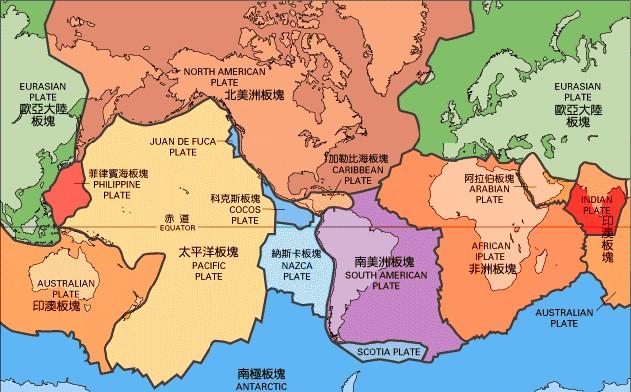In 1968, french geologist Savile LePichon divided the entire crust into six major plates: the Eurasian Plate, the Pacific Plate, the American Plate, the African Plate, the Indian Ocean Plate, and the Antarctic Plate. The division of the world's six major plates has been widely recognized by the scientific community. With the exception of the Pacific Plate, which is almost entirely oceanic, the remaining five plates include both continents and oceans.
So, in addition to eurasia, North America, South America, Africa, Oceania, and Antarctica ( the continent ) , does the continent of Asia , the continent of Asia , the continent of Antarctica ( the continent ) , exist in the world?

Earth's plate structure
<h1 class="ql-align-justify" > does the sunken continent of Zealand really exist? </h1>
Doubts about the existence of the Continent Ofeland have persisted for nearly a century before they were dispelled.
As early as the nineteenth century, European colonists inferred that New Zealand was part of a sunken continent (and only extrapolated, of course).
Entering the twentieth century, with the development of science and technology. Deepwater mapping techniques depict new Zealand's northern and southern islands not really being two lands that grow out of the seafloor, but are part of a huge continent.
In 1995, the American geographer Bruce Luyendyk first used the concept of Zealandia. But he only used to describe the fragments of the north and south islands of New Zealand, French New Caledonia, and the supercontinent gondola that exploded 200 million years ago, not the new continent.
Subsoil sonar imaging
In 2017, a group of geologists, after more research, was convinced that Zealand was a vast continent with hard edges, made up of continental granite, rhyolite, sandstone and schist, whose clear boundaries, dimensions, elevation above the oceanic crust and type of rock all gave it evidence and qualifications in the geological sense of the youngest and eighth continent on Earth (or seventh if Asia and Europe counted as a continent).
The researchers believe that to become a continental plate, four elements must be possessed:
The first element is higher than the oceanic crust: the continental plate needs to rise from the seabed on relatively high land;
The second is the diversification of element rock types: igneous rocks formed by volcanic eruptions, metamorphic rocks formed by heat and pressure, and sedimentary rocks caused by erosion;
The thickness of the third element of the earth's crust: that is, the thickness of the surface to the ground magma reaches 10 to 30 kilometers, and the crust is thicker and less dense than the surrounding seabed;
The fourth element must be a sufficiently large continent: an area of 1 million square kilometers, with well-defined boundaries, which can be considered a continent rather than a miniature continent or continental fragment;
Geologists have confirmed that Zealand meets the first three criteria. Trickier, Sealand is divided into north and south segments by two tectonic plates, which makes it look like a continental fragment rather than a unified plate.
In recent years, based on satellite data and rock samples. The researchers believe that Zealand was once part of the continent of Gondwana, and that it migrated in a manner similar to Antarctica and Australia; New Zealand and New Caledonia are not just a chain of islands or part of the Indian Ocean Plate (Australia), but a single, 4.9 million square kilometers of continental crust plates. The vast majority of the continent is submerged in the ocean, with only 5% of the area exposed to the surface of the sea becoming islands.
Whether Zealand can finally be universally recognized by the international scientific community will continue to be tracked and monitored.
<h1>What will happen to the resurfacing of Zealand? </h1>
Topographic map of the sunken continent of Zealand
Climate simulation of the continent of Zealand
Simulation of vegetation types and administrative districts in Zealand
Resources and land use map of Zealand
If the existence of the Zeeland continent is generally affirmed by the scientific community. Then the impact of its resurfacing will be unprecedented:
1. Oceania will surpass Europe to become the sixth continent geographically, and it is only a little bit away from Antarctica. New Zealand will then become another great power in the southern hemisphere, and will be at the forefront of the world in terms of land area and resource endowments.
2. The area of temperate oceanic climate in the entire world climate type will increase significantly, and the overall climate environment of Zealand will be very superior (it will become the only continent in the southern hemisphere with subarctic coniferous forests and tundra belts).
3. The reappearance of the Zealand continent is nominally the territory of New Zealand, but in fact it is jointly developed. A world-class wave of immigration is more likely to emerge.
Geographically defining Zealand as a continent makes much more scientific sense than adding a name to the list of continents. A continent can be submerged but remain intact, which helps explore the cohesion and division of the continental crust. If this continent could resurface, it would have as much impact as Columbus's discovery of the American continent.
Text: Geography Online | Typesetting: Geography Online | Source: Network Finishing
Geography Online | we believe in using the power of geographic knowledge to understand the world